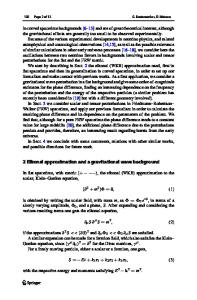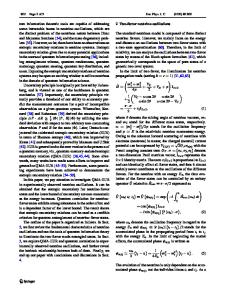Neutrino Masses, Neutrino Oscillations, and Cosmological Implications
Theoretical concepts and motivations for considering neutrinos having finite masses are discussed first. Following this, the experimental situation on searches for masses and oscillations is summarized. This includes a discussion of the solar neutrino pro
- PDF / 27,536,061 Bytes
- 476 Pages / 481.89 x 691.654 pts Page_size
- 69 Downloads / 355 Views
Proceedings of the XXI. Internationale Universitatswochen fur Kernphysik 1982 der Karl-Franzens-Universitat Graz at Schladming (Steiermark, Austria) February 25th-March 6th, 1982
Sponsored by Bundesministerium fur Wissenschaft und Forschung Steiermarkische Landesregierung International Centre for Theoretical Physics, Trieste Sektion Industrie der )k+oo
For the high energy behaviour of an S-matrix element each longitudinally polarized vector boson will therefore produce one extra power of momentum. Let us now investigate the possible self-couplings of a set of massive hermitian vector fields Wa (a = 1, •.. ,N). 11 Because each Wa has canonical dimension one we can have at 11
most quartic couplings if we wish to avoid coupling constants with negative mass dimensions in order not to jeopardize renormalizability from the very beginning. The most general interaction has the form [11]
10
Lint (W)
= 21
a
+
12
b
+
12
c
+
14
e aSyo £
aSy
Wy (WS,v a]..l Wa ]..I v
(a
+--+
13»
aSy
wy (W S , v a]..l tva + (a v ]..I
+-+
13) ) +
aSy
eYVAp wa wS a wy + 1 d wa wS,]..I wy Wo,v+ 4 aSyo ]..I ]..I v A p v ]..IVAp
-
wa wS wy WO ]..I v A P
+
(2.11)
with obvious symmetry relations for the real coupling matrices a, b, c, d, e. Taking into account the derivative cubic couplings and remembering (2.9) and (2.10) one finds that the Born terms for WW -+ WW shown in Fig. 1 may diverge as badly as k 6 for large k. However, for certain values of the coupling constants miraculous cancellations take place. It turns out [11] that the most gentle high energy behaviour can be obtained if the following relations hold: b
=
c
=
e
=
(2.12a)
0
(2. 1 2b)
aaSy totally antisymmetric a
2d
aSyo
= a £ao
a
£yS
+ a
£ay
a
£013
ayo
o
(2.12c) (2.12d)
Note that even with the relations (2.12l the scattering amplitude for WW -+ WW still diverges like k 2 if all external particles are longitudinally polarized. What about the couplings to fermions as in (2.7)? The most general interaction of dimension < 4 is (2.13)
where again a
=
1, ... ,N; a, b label the different fermions
in the theory and L , R are hermitian coupling matrices. a a Calculating the amplitudes for the scattering process FF -+ WW
11
from the diagrams in Fig. 2 one finds that the amplitude behaves like k 2 for large k if both vector mesons are longitudinally polarized unless [LN,L a ] "'''
=
i a
exSy
L
(2.14a)
y
(2.14b) The requirement of smooth high energy behaviour has led to a remarkable algebraic structure: the relations (2.12b) and (2.12c) define a Lie algebra and the coupling matrices for both left-handed
(1+yS) and
right~handed
(1- y S) fermions must
be representations of this Lie algebra. Note that the leftand right-handed fermions may define completely independent representations L , R . ex ex As before, the relations (2.14) are in general not sufficient to guarantee a satisfactory high energy behaviour for longitudinally polarized vector bosons,but instead the amplitudes increase as
~k
for large k with a generic fermion
ma











